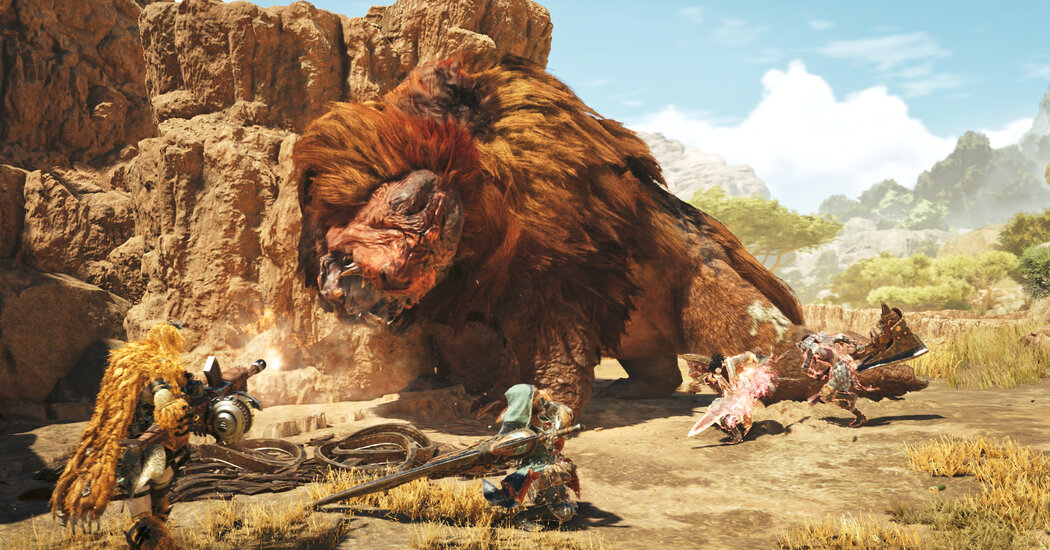Massive reptiles bask on sunlit rocks as golden grass ripples gently in the breeze.
You might be a seasoned monster hunter, a master of slaying beasts with a gleaming blade, but a companion urges you to pause and observe the world around you. A button press allows you to focus on the radiant creatures before you, revealing a gathering of females encircling a spiked, dominant male. As the camera zooms in, small creatures scurry at your feet, heading toward a distant carcass for their next meal.
The grandeur and intricate ecological detail of Monster Hunter Wilds evoke the feeling of stepping into a fantastical David Attenborough documentary.
However, the name of this iconic Japanese series leaves little doubt about its core premise: these are primarily monster-hunting games, a franchise that has thrived on thrilling battles for over two decades. Yet, the tension between the awe of exploring vibrant ecosystems and the act of carving up defeated creatures for loot lingers as a poignant undercurrent.
“There’s an odd dissonance at the heart of Monster Hunter,” said Jacob Geller, a critic and YouTube essayist. “Unlike many other games, it’s clear that these creatures aren’t inherently malevolent, which makes hunting them undeniably unsettling.”
More than any of its predecessors, Monster Hunter Wilds, which launched Friday for PC, PlayStation 5, and Xbox Series X|S, explores the delicate interplay between the stunning beauty of its creatures, their interconnected ecosystems, and the player’s primary role as their hunter.
“Nature is abundant and breathtaking,” said Yuya Tokuda, the game’s director, through an interpreter. “But in an instant, it can become wild, unforgiving, and fiercely violent.”
Early in the journey, players might stumble upon the serpentine Balahara coiled tightly around the lion-like Doshaguma in a fierce battle. These unscripted encounters are pure gaming brilliance, showcasing lifelike A.I.-driven clashes that feel almost uncomfortably real.
As one beast succumbs to the other, the player will likely dive back into the action, blade sharpened and ready. Inflict enough damage on the Doshaguma, and it begins to limp away. Its expressive animations vividly convey its struggle as it retreats to its lair.
With each new installment — Wilds being the sixth core entry — the franchise has leaned further into believable life sciences. Energy flows naturally through its food chains, from tiny insects and plants to the colossal apex predators. Whether it’s a lush Mesozoic rainforest or a cavernous network where oil pools in silty depths, the game’s ecosystems feel authentic and alive.
On the Windward Plains, a sprawling region of dunes, grasslands, and weathered rock formations, the death of a small herbivore doesn’t result in its body simply vanishing. Instead, it decomposes into bones, attracting carrion birds and insects eager to feast. In time, its remains might seep into the soil, giving rise to peculiar mushrooms at the site of its demise.
This level of detail draws from real-world concepts like whale fall, where a whale’s carcass sustains an underwater ecosystem for years.
“The ecosystem unfolds around the player, whether they choose to interact with it or not,” Tokuda explained.
For decades, video game creators have dreamed of crafting virtual ecosystems as complex as nature itself. In 1992, SimLife allowed players to design habitats where creatures ate, evolved, and reproduced. Twenty-five years later, Rain World depicted a dynamic food chain of eerie creatures in a desolate 2D world.
Now, thanks to advanced hardware, the wildlife of Monster Hunter Wilds isn’t just visually stunning but behaviorally intricate. Players can seamlessly transition from human settlements to creature-filled biomes, encountering monsters like the electrifying Rey Dau, a fearsome lightning dragon.
Beyond its fearsome monsters, the game’s standout character is Nata, a young refugee separated from his community in the mysterious Forbidden Lands. Unlike his people, Nata does not hunt the colossal creatures. Instead, he represents a perspective rooted in contemporary concerns: a mix of awe and trepidation toward nature, rather than the overused trope of the nature-revering native.
Much like our changing world, the migratory patterns of creatures like the scaled simian Ajarakan have been thrown into chaos. Seasonal cycles, known in the game as the Plenty, Fallow, and Downpour, are out of sync. Yet the game’s rich and imaginative ecology, rivaling that of Studio Ghibli’s nature-inspired masterpieces, never ceases to amaze — even when it takes the form of a towering predator eyeing you as its next meal.
Tokuda aims to instill not joy in vanquishing these creatures nor sorrow, but a sense of responsibility. This is reinforced by a narrative twist: as a licensed monster hunter, you must receive authorization before engaging a target. Alma, your pragmatic handler, carefully assesses the situation: Is the creature an immediate threat to humans? Does it disrupt the balance of its ecosystem?
“Taking a life in this world carries a heavy burden,” Tokuda stated. “It’s not a decision to be made lightly.”
Tokuda’s fascination with the cycles of life, death, and renewal is evident — perhaps inspired by his own collection of a dozen pet reptiles.
“My home in Japan is like a miniature version of the Ancient Forest from Monster Hunter: World,” Tokuda joked, referencing the 2018 game. Keeping his pets thriving requires the same principles that make Monster Hunter Wilds so immersive. “You have to recreate an ecosystem on a smaller scale,” he explained.
This dedication to authenticity is why Monster Hunter Wilds feels so genuine. For Tokuda, nature’s interconnected systems are far more than decorative backdrops. “They form a believable ecosystem,” he said. “That has always been my ultimate goal.”

Leave a Reply